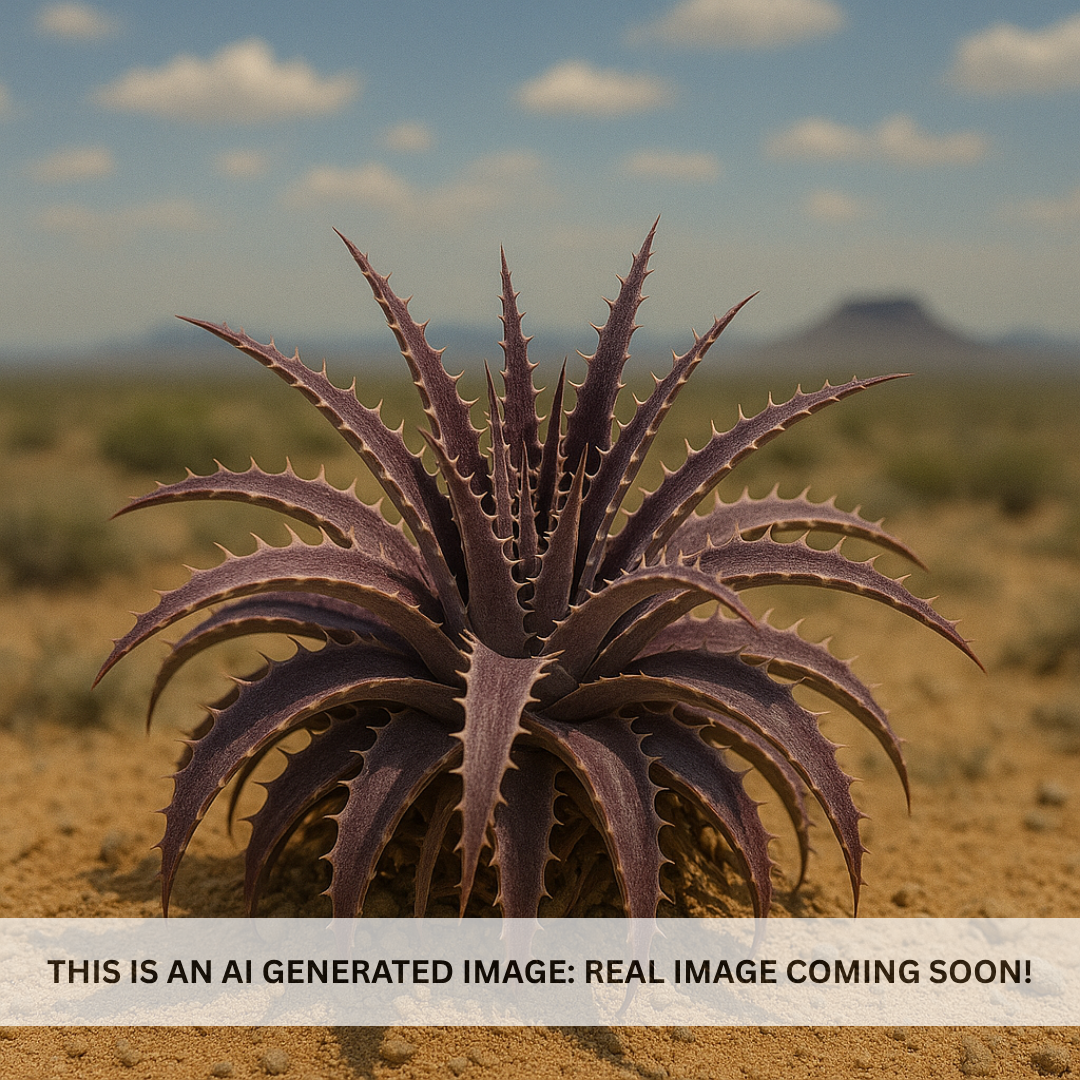My Store
Grape Jelly Dyckia
Grape Jelly Dyckia
Couldn't load pickup availability
Plant Type: perennial, bromeliad (terrestrial succulent)
Plant Height: 10–14 inches
Spread: 16–20 inches
Flower Color: bright orange-red to tangerine
Sun Exposure: Full sun to partial shade
Grape Jelly Dyckia (Dyckia ‘Grape Jelly’): Rich Color and Razor-Edged Beauty for the Desert Landscape
The Grape Jelly Dyckia (Dyckia ‘Grape Jelly’) is a bold, jewel-toned bromeliad that adds intensity and sculptural contrast to Arizona landscapes. With its deep purple to violet foliage rimmed in silver spines, this plant is as visually rich as its name implies. Compact yet dramatic, Grape Jelly offers year-round interest—its metallic sheen, geometric rosette shape, and fiery orange flower spikes make it a powerful accent in modern, tropical, or desert-inspired designs.
Key Features of Dyckia ‘Grape Jelly’
This hybrid Dyckia forms a compact rosette of rigid, triangular leaves that shimmer in shades of plum, grape, and smoky violet. The color deepens in full sun, giving the plant a velvety, dark sheen that contrasts beautifully with its sharp, frosted-white spines.
In spring and early summer, tall bloom stalks rise from the center of the rosette, reaching up to 18 inches tall and crowned with clusters of bright orange to red tubular flowers. These blooms attract hummingbirds and pollinators while standing out vividly against the dark foliage.
Over time, Dyckia ‘Grape Jelly’ produces small offsets at its base, forming dense clumps that enhance its architectural appeal. It’s both exotic and durable—thriving in the same arid conditions as agaves, aloes, and cacti while offering richer color and more refined structure.
Growing and Care Tips
The Grape Jelly Dyckia thrives in full sun to partial shade. Full sun brings out its deepest purple tones, while partial shade produces softer plum and bronze hues. It requires well-draining soil—a sandy or rocky mix is ideal to prevent root rot.
During establishment, water every 10–14 days, ensuring the soil dries completely between waterings. Once established, water sparingly—every 3–4 weeks in summer and rarely in winter. Occasional deep watering encourages color richness and flower production but avoid constant moisture.
This plant is hardy down to about 20°F and handles Arizona’s extreme heat with ease. A light feeding with diluted succulent fertilizer in spring enhances both growth and bloom vigor.
Trim away old flower spikes and any dried leaves near the base to maintain a clean, polished appearance. Handle carefully—its spines are sharp and rigid.
Landscaping Uses
Dyckia ‘Grape Jelly’ is a striking choice for rock gardens, modern xeriscapes, and high-contrast plantings. Its saturated color and symmetrical rosette shape add drama and sophistication when used among silver or green desert plants like Agave parryi, Blue Glow Agave, or Golden Barrels.
It shines as a focal accent in decorative pots, raised planters, or mass plantings along borders. The combination of metallic foliage and vivid blooms creates a year-round statement piece that bridges tropical vibrancy with desert resilience.
In minimalist designs, it pairs perfectly with black gravel, steel edging, or concrete elements, emphasizing its jewel-like quality and geometric precision.
Summary
The Grape Jelly Dyckia (Dyckia ‘Grape Jelly’) is a masterpiece of color and form. With its deep purple foliage, silver spines, and glowing orange flowers, it brings bold contrast and sculptural beauty to any Arizona garden. Hardy, low-maintenance, and highly ornamental, it thrives where few plants can—offering luxury and toughness in equal measure.
Three Timbers Installation Guide (Feel Free to Follow)
Dyckia ‘Grape Jelly’ Planting Guide
Location: Full sun to partial shade; full sun intensifies purple coloration, while partial shade protects against scorching in highly reflective areas.
Soil: Use well-draining cactus or succulent soil with added sand, gravel, or pumice for improved drainage and aeration.
Spacing: Space 16–20 inches apart to allow for mature width and offset growth.
Planting Depth: Set the crown level with or slightly above surrounding soil to prevent water accumulation at the base.
Support: None required; rosette form is naturally stable.
Watering Guide
Watering After Planting: Water deeply once after planting to settle the soil and eliminate air pockets. Allow the soil to dry fully before watering again.
When is the Plant Established? The Grape Jelly Dyckia is considered established after 6–9 months, once offsets begin forming and color deepens.
Watering Once Established: Water every 3–4 weeks during extended dry periods in summer and once every 6–8 weeks in winter. Always confirm the top few inches of soil are dry before watering again.
Drip Irrigation Setup: Use one low-flow emitter (0.5 gallon per hour) placed 6 inches from the rosette edge. Allow soil to dry fully between irrigation cycles.
General Watering Tips: Avoid overhead watering to prevent moisture from collecting between leaves. Use decorative gravel or crushed rock to retain warmth, limit weeds, and keep the plant’s crown dry—maintaining a few inches of spacing for airflow.
Share












